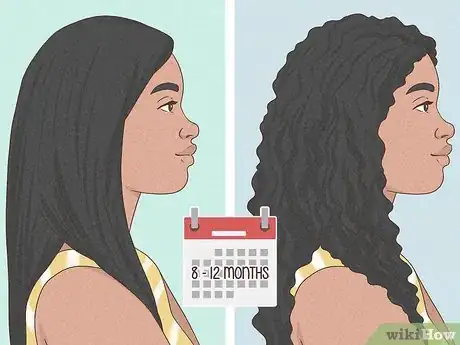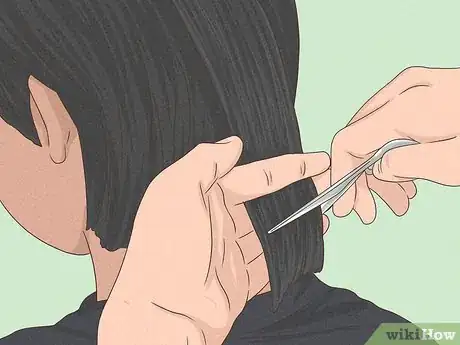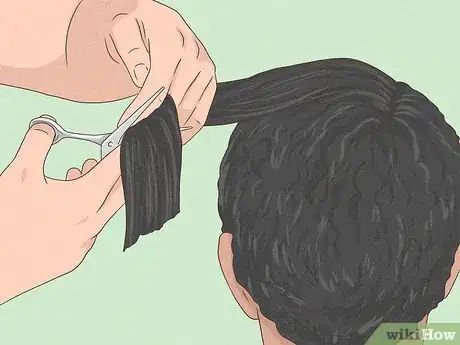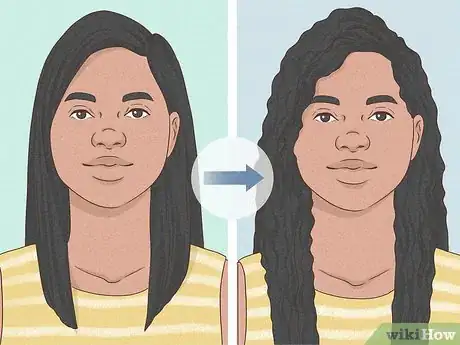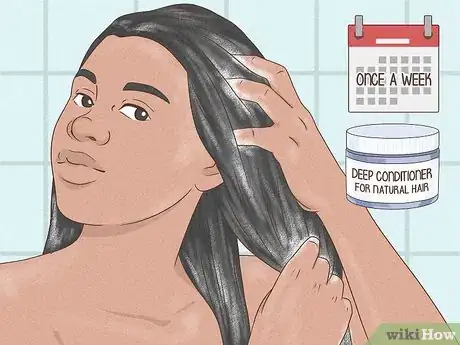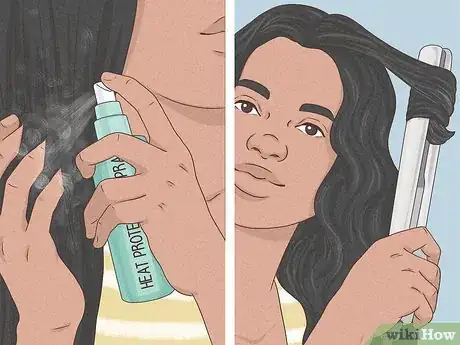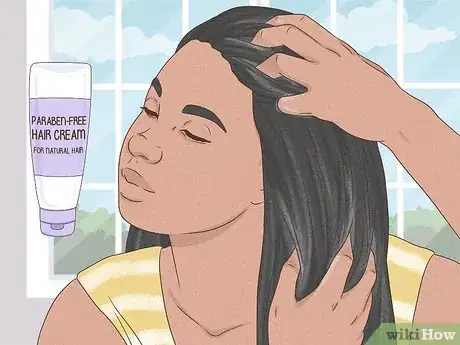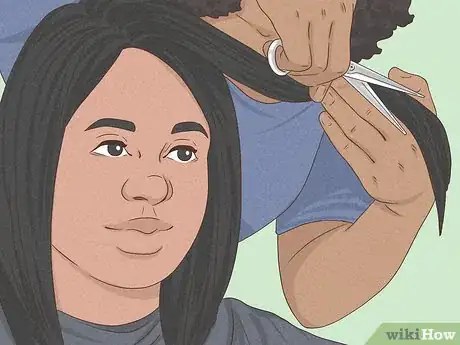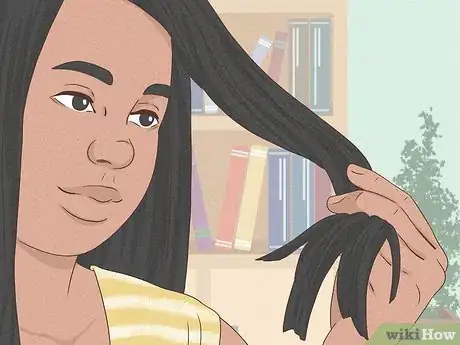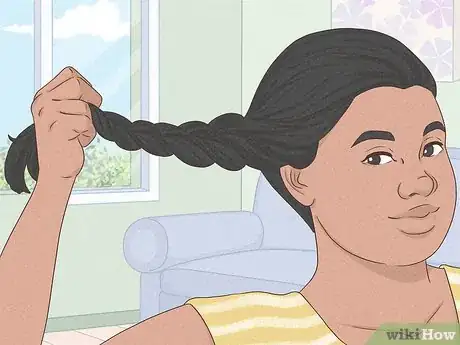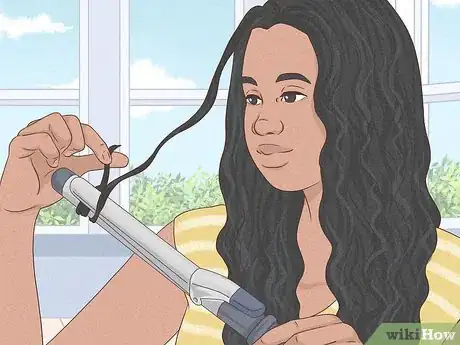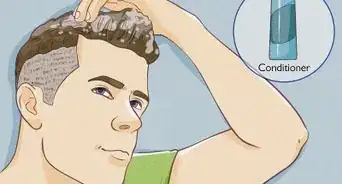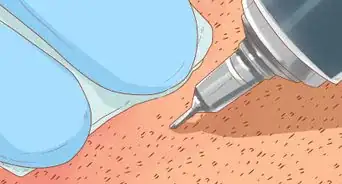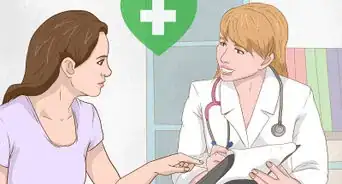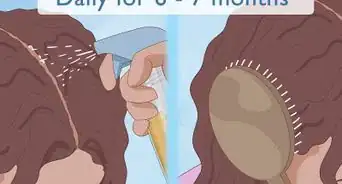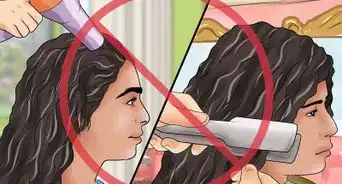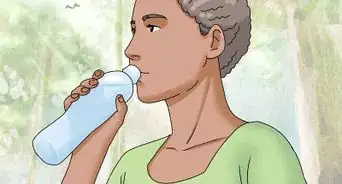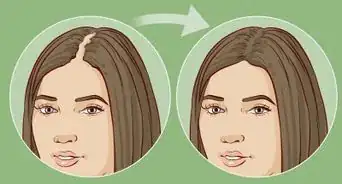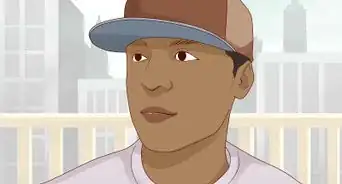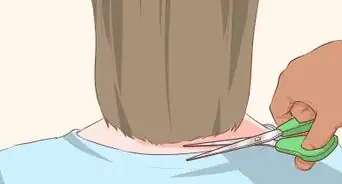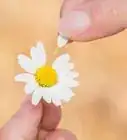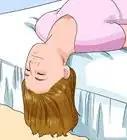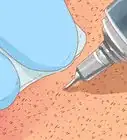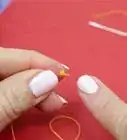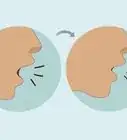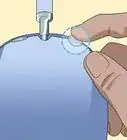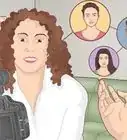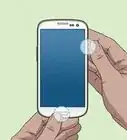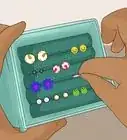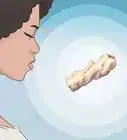This article was co-authored by Christine George and by wikiHow staff writer, Eric McClure. Christine George is a Master Hairstylist, Colorist, and Owner of Luxe Parlour, a premier boutique salon based in the Los Angeles, California area. Christine has over 23 years of hair styling and coloring experience. She specializes in customized haircuts, premium color services, balayage expertise, classic highlights, and color correction. She received her cosmetology degree from the Newberry School of Beauty.
There are 13 references cited in this article, which can be found at the bottom of the page.
This article has been viewed 20,133 times.
If you’re ready to let go of your treated hair and bring back those natural locks, you may be wondering how long it’s going to take. The good news is that even if it’s going to be a few months before you can get your natural hair back, there’s plenty you can do to disguise your chemically-treated hair, maintain a uniform texture, and encourage hair growth in the meantime. If you ever grow tired of that combination of treated and natural hair as you’re growing it out, just remind yourself of how good you’re going to look when you’re done!
Steps
How long does it take for your hair to fully transition?
-
1It will take roughly 8-12 months if you just let your hair grow. If you want to transition by growing your hair out, you’ll see and feel your natural hair coming in over the first 1-3 months. By the end of 8 months, most people will have roughly 2–3 inches (5.1–7.6 cm) of new growth, and the chemical straightener will be on its last legs. Once you have enough natural hair to be happy with it, see your stylist and get the remainder of your treated hair trimmed off.[1]
- Make sure that you condition your hair regularly and moisturize with coconut oil while you’re growing it out. This will keep your new natural hair from drying out as it grows.
-
2You can speed things up if you do a “big chop". The big chop is what it sounds like—you cut off all of your chemically-treated hair and just go for a shorter style. This may help speed up the process too, since the treated ends of your hair won’t be around to soak up precious nutrients. If you’re interested in going short, there’s no time like now! Make an appointment with your stylist and get that treated hair chopped off.[2]
- There is a middle ground here. If you’d like to potentially accelerate growth but you don’t want to go all the way to short hair, trim your dead, knotted, or split ends after each wash.[3]
Is it better to “big chop” or transition?
-
1A big chop is ideal if you want the relaxer out ASAP. If your goal is to get back to natural hair as quickly as possible, the big chop is the winner. Go see your stylist for a big cut if you’re comfortable with short hair and you enjoy rocking that look.[4]
- If you’ve never had super short hair and you’re worried about the way it will look, don’t beat yourself up over wanting to hold on to your beautifully long hair.
- Just keep in mind, you’re still going to need to wait to grow your long hair out.
-
2Growing it out is better if you don’t want short hair. If you’d prefer to keep your hair longer while you grow it out, no problem! You can always just let father time do his thing. There’s plenty you can do in the meantime to speed the process up and blend the two textures.[5]
- If you know you look good with short hair or you’ve always wanted an excuse to give short hair a shot, feel free to chop it off. There’s nothing wrong with going that route.
- There are no right or wrong answers here, so do whatever makes the most sense to you.
How can I speed up transitioning to natural hair?
-
1Deep condition more often, and wash less often. Wash your hair no more than once a week. On wash days, use a deep conditioner to lock in moisture and protect your hair.[6] Not only will this keep your newer, natural hair healthy, but it will make the difference between your chemically-straightened hair and natural hair less noticeable.[7]
- Use a shampoo with no sulfates in it. Sulfates are notorious for damaging hair and limiting growth.
- Your hair will be fragile while you transition to natural hair, and over-washing it may damage your hair.
-
2Stay away from heat to keep your hair strong. Curling irons, straighteners, and hair dryers will all damage your hair if you overdo it.[8] The heat strips your hair of natural proteins, which causes it weaken and dry out. Laying off of the heat entirely will help your hair grow healthy.[9] If you do want to use a ceramic comb or iron, only use it once a week and use a heat protecting product before you style.[10]
- If you do need to use a hair dryer, use the lowest heat setting available and keep moving it back and forth to keep the heat from building up in any single location for too long.
- The less tools you use, the better—your hair should be thick and healthy![11]
-
3Don’t overdo it with the products to keep your hair healthy. The less you put on your hair, the faster it will grow. Thick products clog your scalp’s pores, which can restrict growth. It also makes it harder for your natural hair to flourish if it’s covered in product. While it’s okay to style it with products every now and then, do your best to let your hair breathe unencumbered by product.[12]
- If you are going to use any styling products, use products designed specifically for natural hair.
- Certain hair products, like volumizing shampoo and conditioner, can also dry out your hair.[13]
How can I style my hair to cover up the transition?
-
1You can experiment with protective styles, like braids. Many folks out there change their hairstyle completely when they transition from chemically-treated to natural hair. You could get braids, weaves, bantu knots, or locs while you wait for the natural hair to grow out.[18] You can even wear a wig if you’d like. Not only will these styles look good, but they’ll also protect your hair as you transition, and no one will be the wiser.[19]
-
2You can use a few well-placed curls to disguise the relaxed hair. Relaxed hair is straighter than your natural hair, but you can always blend the two together with some mechanical curls. This way, the shape of the hair will match, even if the textures aren’t necessarily identical. You can use a two-strand twist out or leave foam rollers in to craft your curls.[22]
- Unless someone is physically touching your hair, nobody should be able to tell that some of your hair is relaxed and some of it is natural!
Warnings
- Unless you have a deficiency, biotin supplements probably aren’t going to do anything for your hair.[23]⧼thumbs_response⧽
References
- ↑ https://www.oprah.com/fashion_and_beauty/jihan-thompson-transitioning-to-natural-hair
- ↑ https://www.self.com/story/transition-tips-for-natural-hair
- ↑ https://www.self.com/story/transition-tips-for-natural-hair
- ↑ https://www.self.com/story/transition-tips-for-natural-hair
- ↑ https://www.self.com/gallery/natural-hair-transition-advice
- ↑ Yan Kandkhorov. Professional Hair Stylist. Expert Interview. 28 January 2020.
- ↑ https://www.instyle.com/hair/natural/transitioning-to-natural-hair
- ↑ Yan Kandkhorov. Professional Hair Stylist. Expert Interview. 28 January 2020.
- ↑ Christine George. Master Hair Stylist & Colorist. Expert Interview. 10 January 2020.
- ↑ https://www.aad.org/public/everyday-care/hair-scalp-care/hair/care-african-american
- ↑ Christine George. Master Hair Stylist & Colorist. Expert Interview. 10 January 2020.
- ↑ https://youtu.be/Fk8n1HjsPkU?t=67
- ↑ Christine George. Master Hair Stylist & Colorist. Expert Interview. 10 January 2020.
- ↑ https://www.self.com/story/transition-tips-for-natural-hair
- ↑ Yan Kandkhorov. Professional Hair Stylist. Expert Interview. 28 January 2020.
- ↑ http://www.blackhairstyle.com/stripping-relaxed-hair-a-how-to-guide-2/
- ↑ https://www.ncbi.nlm.nih.gov/pmc/articles/PMC1785201/
- ↑ https://www.refinery29.com/en-us/easy-natural-hairstyles
- ↑ https://www.self.com/story/transition-tips-for-natural-hair
- ↑ https://www.ncbi.nlm.nih.gov/pmc/articles/PMC5896661/
- ↑ https://www.self.com/story/transition-tips-for-natural-hair
- ↑ https://www.self.com/story/transition-tips-for-natural-hair
- ↑ https://www.hsph.harvard.edu/nutritionsource/biotin-vitamin-b7/
